Configuration and Development
Creating a New App SDK Application
By default, App SDK application management is disabled. You’ll have to request your RingCX Digital project manager to grant you the permission to manage them.
In RingCentral's RingCX Digital administration section, you’ll get the « Dev tools » menu section and « Developed applications (SDK) » menu item in the administration and be able to create new ones.
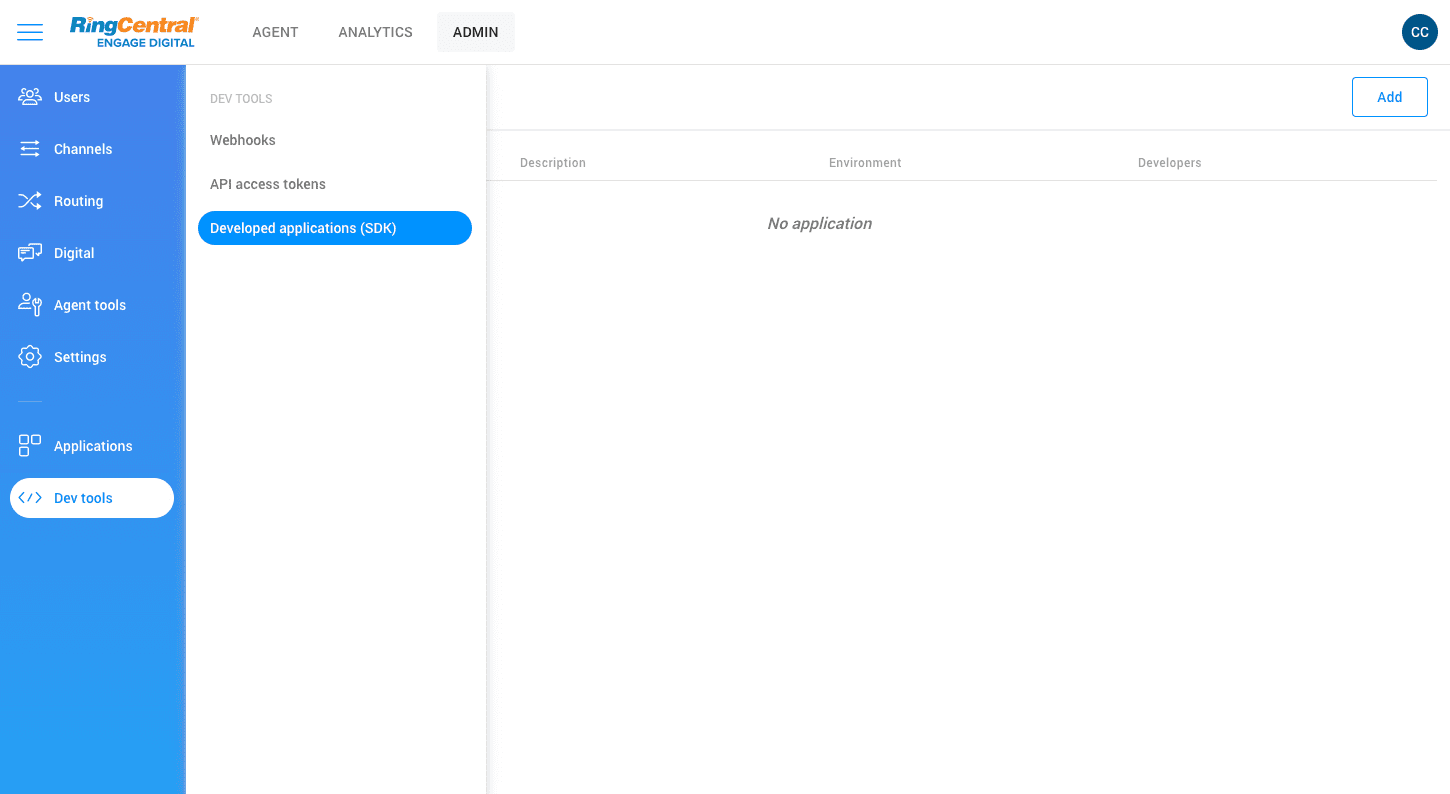
Click on the Add button to start adding your own application.

An application is defined by the following attributes:
| Attribute | Description |
|---|---|
Name |
An unique name that describes the application. This name is mandatory. |
Description |
A short description of what the application does. |
Mode |
The application current mode (by default: development). See available modes below for more details. |
Developers |
The list of agents that are able to develop this application. 25 developers can be added at maximum. |
Callback URL |
The callback used for OAuth authentication (more details in OAuth authentication section). |
Configuration URL |
If present, this URL is used to configure each SDK installation. See installation section for more information. |
Source code URL(s) |
The URL(s) of the JavaScript code you wrote that you have to host on a public server. The created code will be automatically imported in all RingCX Digital application pages. |
Available application modes are:
| Mode | Description |
|---|---|
Development |
In this mode, code is integrated directly, and therefore, updated on each refresh of the RingCentral RingCX Digital page. The code is, however, not executed in a sandbox. JavaScript code is included in page only for users that are in the application's developers list. |
Pre-production |
In this mode, JavaScript code is integrated in a sandbox (only some methods are available) and updated every hour. JavaScript code is included in the page only for users that are in the application's developers list. |
Production |
In this mode, JavaScript code is integrated in a sandbox (only some methods are available) and updated every hour. JavaScript code is included for all RingCentral RingCX Digital agents. |
The best practice is to develop the application in development mode. When the application seems to be ready, it should be switched to pre-production mode. Then if everything is working correctly, it has to be switched to production mode. Note that to have live refresh of code, it must be in development mode.
Installation
When created, the application must be installed in order to make it available on the domain. Installed applications can be found under « Applications » in the « Installed Apps » menu section.
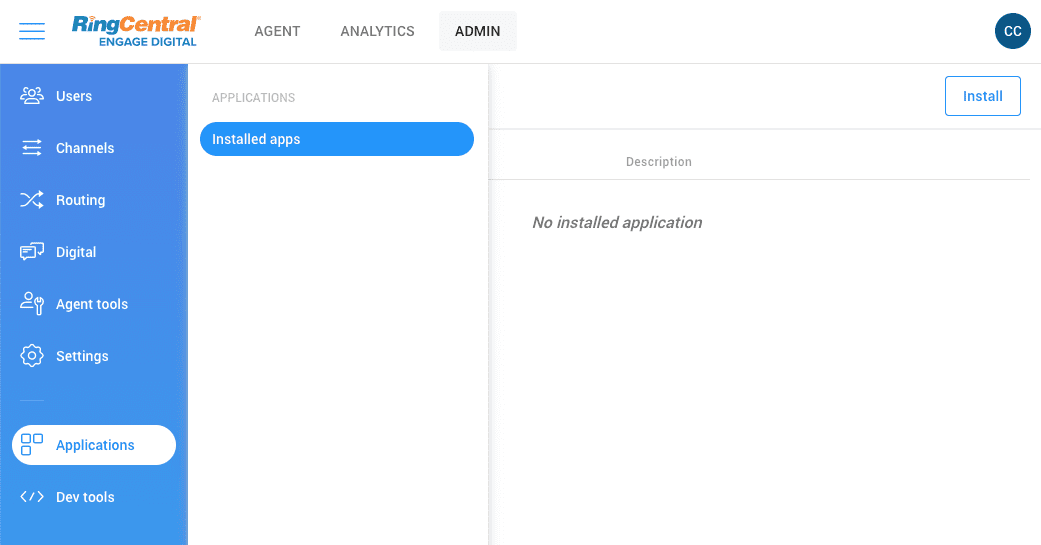
Click on the Install button, choose the application you want to install, and confirm your selection. By default, only certified and local applications are available in the list. Other applications could be installed if you get its installation link.
Once installed, the application can be configured (if the configuration URL has been specified). Look for the gear icon to configure your application.

If the configure button is clicked, an iframe overlay is rendered with the application’s configuration URL plus current domain name as parameter. Example if application configuration URL is http://example.org and current domain name is google, the iframe URL will be: http://example.org?domain=google.
The configuration overlay window aims to set domain dependent settings of the application.
Note
This URL must be authenticated, see OAuth section for more information.
Permissions
An App SDK application could be granted a set of permissions. API calls may require a permission to be set before an API call is allowed. A 403 error will be returned if the application or current user is not granted the proper permission.
By default all permissions are disabled. To enable one or many of them click on the edit permissions icon as shown.
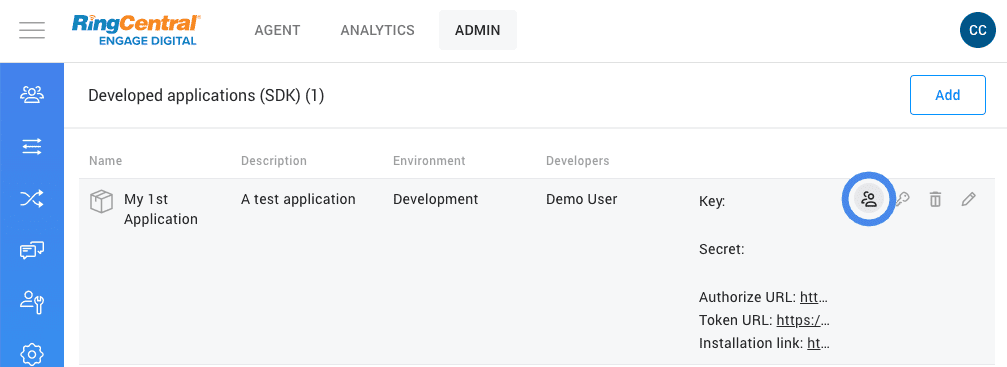
This will bring a pop-up window where you can check the permissions you want your application to have.

If you change the application's permissions, installations are required to update their permission. Navigating to the installations administration section you will see the following message:

Upon clicking the update permissions icon, you will need to confirm you are ready to update the permission of the installed application.
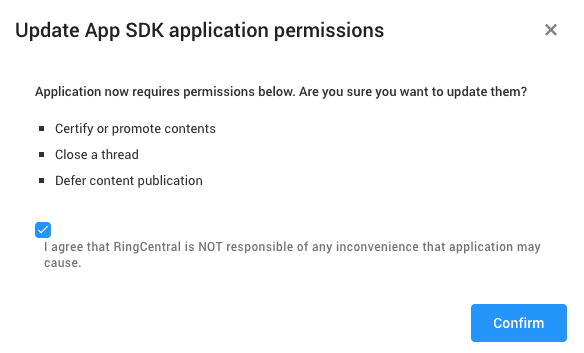
IFrame Messaging
The RingCX Digital App SDK offers iframe rendering features. The main inconvenience with iframes is the communication with the parent window (RingCX Digital).
The RingCX Digital App SDK offers via window.postMessage method the feature to send messages from an iframe to the RingCX Digital window. You will get more details on how window.postMessage works in this technical review.
Sending a Message to RingCX Digital Window
On the iframe side, here is an example of how to send a message to the RingCX Digital window:
window.parent.postMessage({
name: "smcc:foo",
data: { identityId: "4f0aa52d656a3d75867f784b" }
}, "http://example.digital.ringcentral.com");
postMessage method takes two (mandatory) arguments:
| Argument | Description |
|---|---|
object |
A javascript object that describes the message. This object contains the following properties:
|
url |
The URL of the RingCX Digital application. For example: "http://foo.digital.ringcentral.com", where foo is your RingCX Digital domain’s name. |
To receive messages in RingCX Digital, first you have to whitelist the iframe sender origin:
SMCC.Window.acceptPostMessageOrigin("https://example.com");
SMCC.Window.onPostMessage("foo", function(data, origin) {
console.log("New data:", data, "from:", origin);
});
OAuth Authentication
RingCX Digital App SDK provides many ways to render iframes. But, most of the time those iframes must be authenticated. The RingCX Digital’s interface offers a standard OAuth 2.0 provider to request access tokens and get RingCX Digital's current user information.
Prerequisites
First of all, you must get your application’s key and secret. Navigate to Dev tools, and then Developed applications (SDK) to get them:
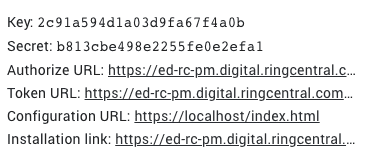
The key and secret are mandatory to make OAuth requests. In order to be secure, iframe authentication callbacks should be in HTTPS. Note that all OAuth requests must be in HTTPS.
You must also configure a callback URL for the application to a valid one. This will be explained later.
Authentication Process
If you are not familiar with the OAuth 2.0 protocol, here is how authentication works:
- User agent is not authenticated on application, a redirection is made on the RingCX Digital OAuth provider with the application key and a redirect URL.
- If the application key is valid, user agent is redirected to the provided redirect URL with authorization code as a parameter. Otherwise the user agent is redirected to the redirect URL with an error parameter.
- Then, the application must make a
POSTrequest with returned code and application secret to get an OAuth access token. - with this access token, the iframe can get the current user infos via REST
/1.0/users/meAPI method.
Request an OAuth Authorization Code
An OAuth authorization code is required before trying to get an access token. User agent must be redirected to the RingCX Digital authorization URL to get it.
URL
https://<domain-name>.digital.ringcentral.com/oauth/authorize
| Parameter | Required? | Description |
|---|---|---|
client_id |
Required | This parameter must be the application key |
redirect_uri |
Required | This parameter must be a valid HTTP(s) URI. Note that the scheme, host, port and path must be equal to application’s callback URL (see configuration section). |
response_type |
Required | This OAuth standard parameter determines the kind of response. Its value must be "code". |
Response
If every parameter is correct, user agent is redirected to redirect URI with a "code" parameter:
https://redirct-uri.com?code=xxx
If authorization fails (user can’t authenticate or does not accept application), user agent is redirected to redirect URI with an error parameter:
https://redirect-uri.com?error=authentication_failed
Note
- The authorization code is unique and random. It also expires quickly.
- Other redirect URI query parameters are preserved.
- If user agent isn’t authenticated when an authorization code is requested, the login form is rendered and authorization is performed when logged in.
If one of the provided parameters is invalid or missing, a 400 HTTP error is returned with a JSON error as body. Here are all available error responses:
| Response Body | Description |
|---|---|
{ |
client_id parameter has been omitted. |
{ |
client_id parameter has been provided but does not match an application. |
{ |
redirect_uri parameter has been omitted. |
{ |
redirect_uri parameter has been provided but URI is malformed (invalid scheme, etc.). |
{ |
redirect_uri parameter has been provided but URI scheme does not match callback URL scheme on application. |
{ |
redirect_uri parameter has been provided but URI host does not match callback URL host on application. |
{ |
redirect_uri parameter has been provided but URI port does not match callback URL port on application. |
{ |
redirect_uri parameter has been provided but URI path does not match callback URL path on application. |
{ |
response_type parameter has been omitted. |
{ |
response_type parameter is present but its value isn’t code. |
Request an OAuth Access Token
To get an access token you must first get an authorization code (see above). Then when the user agent is redirected to the application (redirect URI), a request must be made by the application to get an access token.
Request
POST https://<domain-name>.digital.ringcentral.com/oauth/token
Response
If all provided parameters are valid, a 200 HTTP response is returned and the access token is rendered in the response body as JSON:
{
"access_token": "06eaea7ac0e0b4b7ac622e81"
}
Otherwise, if one of the provided parameters is invalid or missing, a 400 HTTP error is returned with a JSON error as body. Here are all available error responses:
| Response Body | Description |
|---|---|
{ |
client_id parameter has been omitted. |
{ |
client_id parameter has been provided but does not match an application. |
{ |
client_secret parameter has been omitted. |
{ |
client_secret parameter has been provided but does not match an application secret. |
{ |
code parameter has been omitted. |
{ |
code parameter has been provided but does not match a valid OAuth authorization code. |
{ |
code parameter is correct but the OAuth authorization code is expired. |
{ |
grant_type parameter has been omitted. |
{ |
grant_type parameter is present but its value isn't authorization_code. |
Getting Access Token User Information
When getting an OAuth access token, you’ll be able to get information for this token. An access token is associated to a RingCX Digital agent. To get the agent’s ID, a REST API request (/1.0/users/me) must be made by an application. Please refer to RingCX Digital REST API documentation for more information.